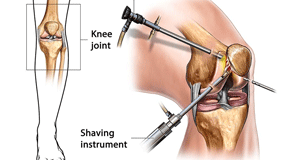Knee Arthroscopy & Sports Injuries
Knee arthroscopy is a minimally invasive surgical procedure. Healthcare providers use knee arthroscopy to diagnose and treat a range of knee injuries. Your healthcare provider makes a small incision and then inserts a long, thin tool with a camera on the end. The camera shows images of the inside of your knee, which helps your healthcare provider make a diagnosis of your injury.

Healthcare providers use knee arthroscopy to diagnose and treat a wide range of knee injuries. During arthroscopic knee surgery, your healthcare provider inserts a tiny camera through an incision. The camera shows the inside of your knee. The images appear on a screen in the operating room. They help your healthcare provider diagnose problems inside of your knee.
Knee arthroscopy is a very common minimally invasive surgical procedure. Minimally invasive procedures require smaller incisions (cuts) than traditional surgery. The incisions are about the size of a keyhole.
To treat injuries or structural problems, your healthcare provider inserts tiny tools through another incision. They use the tools to repair or remove damaged tissue.
- ACL tears.
- AC joint arthritis and separations.
- Bursitis and impingement.
- Shoulder joint fractures.
- Torn rotator cuffs.
- Meniscus tears.
- SLAP and Bankart labral tears.
- Cartilage damage and ligament tears.
You may need knee Arthroscopy if you have:
- Soft tissue injuries: Soft tissues include ligaments (they connect bones to bones) and tendons (they connect muscles to bones). Some of the most common knee injuries are bursitis, torn meniscus, patellar tendonitis, anterior cruciate ligament tear (ACL tear) and tears of the medial collateral ligament (MCL tear).
- Fracture: Bones can break or chip off inside of your knee. Sometimes, pieces of cartilage (rubbery tissue that helps bones move against each other smoothly) can break off when your bone fractures.
- Inflammation: The synovium inside a joint can become inflamed (swollen and irritated). Synovium is soft tissue on the inside of a joint. Healthcare providers call this condition synovitis.
knee Arthroscopy Procedure
During the procedure, Orthopedic Surgeon:
- Cleans your leg and secures your knee in a stabilizing device. The device ensures that your knee stays in the proper position throughout the procedure.
- Makes a small incision (cut) in your knee and inserts a long metal tool called an arthroscope into the incision. The arthroscope has a camera on the end. Images from the camera appear on a screen in the operating room.
- Looks at the images on the monitor and uses them to diagnose injuries and guide the procedure. If you need surgery, your healthcare provider makes other incisions in your knee and inserts tiny tools through them.
- Repairs torn tissues, shaves off damaged bone or cartilage and removes inflamed or damaged tissues. Your healthcare provider uses specially designed tools for these tasks.
- Closes the incisions with stitches or small bandages, and wraps your knee with a larger bandage or dressing.
After your procedure, you should:
- Stay off of your feet: Avoid putting weight on your knee for a few days. You may need crutches or a walker to help you get around.
- Elevate your knee: To reduce swelling and relieve pain, rest with your leg elevated. Try to keep your knee above your heart.
- Take pain medication: Your Orthopedic Specialist may recommend over-the-counter nonsteroidal anti-inflammatory drugs (NSAIDs) or prescription pain medication. Be sure to follow your Doctor’s instructions when taking pain medication. You may also need drugs to reduce swelling or prevent blood clots.
- Keep your incisions covered. Make sure the bandage stays on your knee, and keep the area clean. Ask your Doctor when you can remove the dressing, take a shower or bathe after your procedure.
After you’ve had time to heal from the procedure, Orthopedic Specialist at Shreya Hospital may recommend physical therapy (PT). A customized PT program can help you gain strength and mobility. Your physical therapist will show you special exercises to increase flexibility, strengthen the muscles that support your knee and avoid another injury.
 Dr Dev Mishra Best Orthopaedic Doctor in Delhi NCR Ghaziabad
Dr Dev Mishra Best Orthopaedic Doctor in Delhi NCR Ghaziabad
